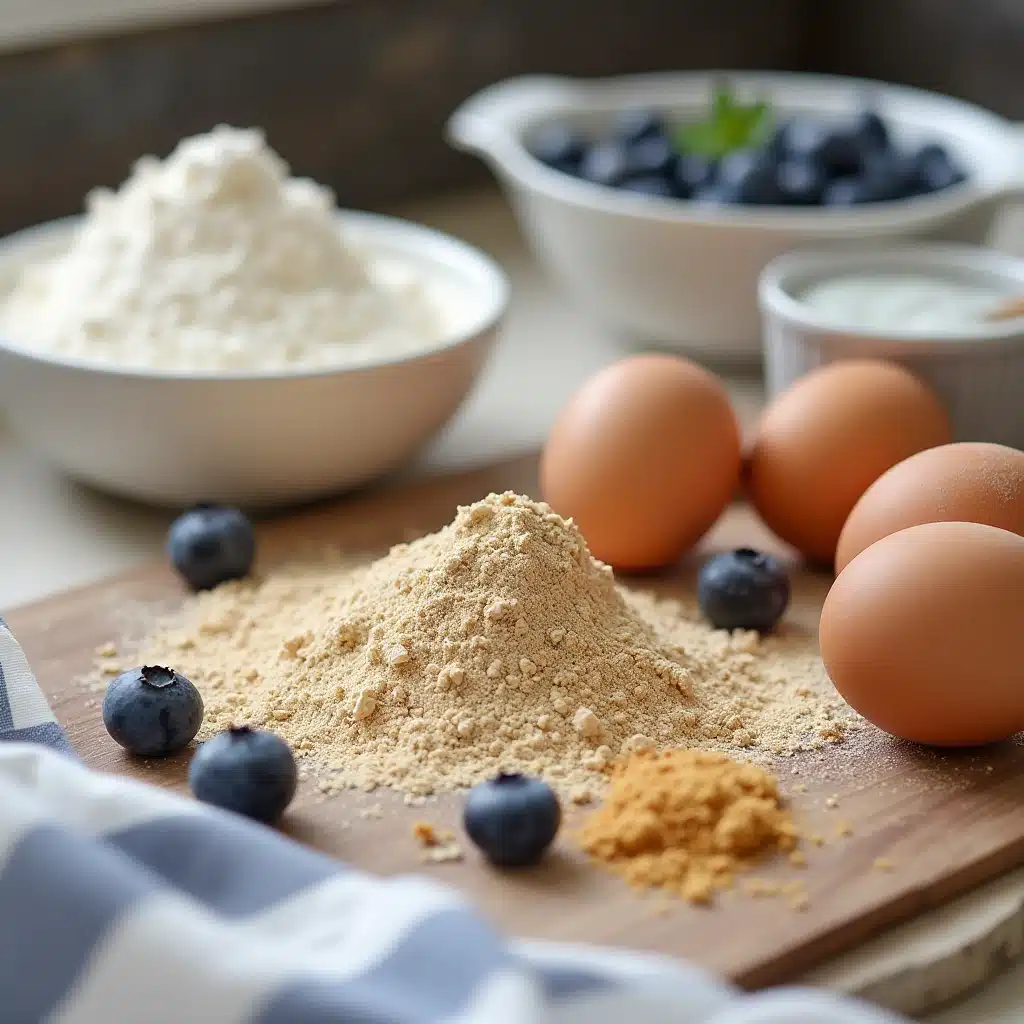Looking for a healthy breakfast that satisfies your cravings and fuels your day? Blueberry protein muffins are the answer. Packed with nutrients, fiber, and high-quality protein, these muffins combine the antioxidant-rich goodness of blueberries with the muscle-repairing power of protein powder. Whether you’re meal prepping for the week, looking for a post-workout snack, or just craving a healthier baked treat, this recipe offers the perfect balance of flavor and functionality.
Let’s dive into the benefits, ingredients, and everything you need to master the art of baking the best blueberry protein muffins.

Table of Contents
Why Blueberry Protein Muffins Are the Perfect Breakfast
The Nutritional Benefits of Blueberries
Blueberries are frequently hailed as a superfood—and for good reason.. These tiny fruits are packed with vitamins C and K, manganese, and powerful antioxidants like anthocyanins, which help fight inflammation and protect your cells from damage. In blueberry protein muffins, they add natural sweetness and a nutrient-rich boost to your morning routine.
Additionally, blueberries have a low glycemic index, so they won’t cause a sharp spike in blood sugar levels.. This makes them an ideal fruit for breakfast, especially when combined with the protein and fiber from whole grains and protein powder.
Why Protein Muffins Keep You Full Longer
Unlike sugary pastries or carb-heavy breakfasts, protein muffins offer sustained energy. Thanks to the vanilla protein powder, Greek yogurt, and eggs, each muffin contains about 9.2 grams of protein. That’s enough to help stabilize your blood sugar and keep hunger at bay for hours.
Protein slows digestion and promotes satiety, which is key for anyone looking to avoid overeating or manage weight. Combined with complex carbs from whole wheat flour and natural fats from eggs and oil, this makes blueberry protein muffins an all-in-one breakfast solution.
Looking for inspiration? Try this meal planning tip for better mornings

Blueberry Protein Muffins
These Blueberry Protein Muffins are truly irresistible—moist, wholesome, and packed with juicy blueberries and a boost of protein. The perfect way to start your day!
- Total Time: 30 minutes
Ingredients
1 cup all-purpose flour
¾ cup whole wheat flour
½ cup vanilla protein powder
1½ tsp baking powder
½ tsp baking soda
½ cup sugar
⅓ cup canola oil
½ cup Greek yogurt
¾ cup whole milk
2 large eggs
1 cup blueberries (fresh or frozen)
Instructions
Preheat oven to 350°F and prep muffin tin.
Mix dry ingredients.
Mix wet ingredients.
Combine wet and dry; fold in blueberries.
Scoop batter into muffin tin.
Bake 18–22 minutes.
Notes
To Freeze: Let the muffins cool completely, then place them in a single layer on a baking sheet. Freeze for 3–4 hours or until fully frozen. Transfer the frozen muffins to an airtight freezer-safe bag and store for up to 6 months. To thaw, simply leave them out at room temperature or refrigerate overnight.
- Prep Time: 10 minutes
- Cook Time: 20 minutes
- Category: Breakfast
- Method: Baking
- Cuisine: American
Nutrition
- Serving Size: 1 Muffin
- Calories: 293
- Sugar: 11.5 g
- Sodium: 141.2 mg
- Fat: 14.5 g
- Carbohydrates: 31.8 g
- Protein: 9.2 g
- Cholesterol: 34.9 mg
Ingredients Breakdown for Blueberry Protein Muffins
The Role of Each Ingredient Explained
Understanding what goes into your blueberry protein muffins not only helps you make smarter choices but also allows you to customize the recipe to your needs. Here’s a detailed look at each core ingredient and how it contributes to flavor, texture, and nutrition.
| Ingredient | Function |
|---|---|
| Whole Wheat + All-Purpose Flour | Combines structure (AP) with added fiber and nutrients (whole wheat). |
| Vanilla Protein Powder | Boosts protein content; adds flavor and structure when baked. |
| Baking Powder & Baking Soda | Leavening agents; help create a light, airy muffin. |
| Sugar | Adds sweetness and contributes to muffin moisture and browning. |
| Plain Greek Yogurt | Adds creaminess, moisture, and additional protein. |
| Canola Oil | Supplies healthy fats and improves the muffin’s soft, tender texture. |
| Eggs | Provide structure, richness, and binding power. |
| Milk (Whole) | Adds moisture and helps blend ingredients smoothly. |
| Blueberries | Natural sweetness, antioxidants, and a burst of juicy flavor. |
Each of these ingredients plays a vital role in both taste and texture. When balanced correctly, you get a moist, high-protein muffin that doesn’t taste like a typical “healthy” baked good.
Substitution Tips for Dietary Needs
Looking to adjust the recipe for allergies or dietary needs? Here are some smart substitutions:
- Flour: Use oat flour or almond flour for gluten-free versions. Mix with a binding agent like xanthan gum if needed.
- Protein Powder: Use unflavored or chocolate for variation; opt for whey isolate if you’re lactose-tolerant or pea-based for vegan.
- Greek Yogurt: Sub with dairy-free yogurt (like almond or coconut-based) to make the recipe dairy-free.
- Canola Oil: Swap with avocado oil or melted coconut oil for a richer taste or added nutrition.
- Sugar: Replace with coconut sugar, honey, or monk fruit for a low-glycemic version.
- Eggs: Use flax eggs (1 tbsp ground flax + 3 tbsp water per egg) for a plant-based alternative.

How to Make Blueberry Protein Muffins (Step-by-Step)
Preparation and Mixing Tips
Making the perfect blueberry protein muffins doesn’t require professional baking skills—just a bit of know-how and the right sequence. Follow these steps for consistently delicious results:
Preheat Your Oven
Start by preheating your oven to 350°F (175°C). Line a muffin tin with paper liners or lightly grease it with oil spray.
Measure Ingredients Precisely
Use measuring cups and spoons. Precision is especially important when working with protein powder, as it affects texture.
Mix Dry Ingredients Together
In a large bowl, whisk together:
1 cup all-purpose flour
¾ cup whole wheat flour
½ cup vanilla protein powder
1½ tsp baking powder
½ tsp baking soda
Pinch of salt
This helps ensure everything is evenly mixed and prevents clumps from forming later.
Combine Wet Ingredients Separately
In another bowl, beat together:
⅓ cup canola oil
½ cup plain Greek yogurt
2 large eggs (room temperature)
¾ cup whole milk (also room temperature)
½ cup sugar
Fold Wet Into Dry
Slowly mix wet ingredients into the dry. Stir gently—overmixing leads to dense muffins. The batter should be thick but scoopable.
Add Blueberries Last
Fold in 1 cup of fresh or frozen blueberries using a spatula. If using frozen, do not thaw to avoid soggy batter.
Fill Muffin Cups
Use a scoop or spoon to evenly distribute batter across 12 muffin cups, filling about ¾ full.
Baking Techniques for a Fluffy Texture
Bake at 350°F for 18 to 22 minutes, or until a toothpick inserted in the center comes out clean.
Don’t open the oven during the first 15 minutes—sudden temperature drops can make the muffins collapse.
Allow the muffins to cool in the pan for 5 minutes before transferring them to a wire rack. This helps retain moisture while preventing soggy bottoms.
Choosing the Best Protein Powder for Muffins
Whey vs Plant-Based: What Works Best?
When baking blueberry protein muffins, the protein powder you choose has a big impact on texture, taste, and nutritional value. Here’s a comparison of the two most popular types:
| Type | Benefits | Best For |
|---|---|---|
| Whey Protein | Quick-digesting, creamy texture, often enhances rise in baked goods | Those who tolerate dairy and want fluffier muffins |
| Plant-Based Protein | Dairy-free, great for vegans, can add a slight grainy texture depending on brand | Vegan or dairy-sensitive individuals |
Whey isolate blends best and results in a smoother texture, while pea or rice protein powders offer a more rustic, denser crumb. If you’re using a plant-based powder, consider increasing the moisture content (like adding an extra tablespoon of Greek yogurt or milk) to counteract dryness.
Flavor Compatibility: Vanilla, Chocolate, or Unflavored?
For blueberry muffins, vanilla protein powder is the gold standard. It complements the fruity sweetness without overpowering it and adds a familiar “baked goods” flavor profile.
However, if you’re experimenting:
- Chocolate protein powder can make a delicious dessert-like muffin with blueberries acting as tart contrast.
- Unflavored protein powder is ideal if you prefer the natural flavor of ingredients to shine through, but it may require additional sweeteners or extracts.
Pro Tip: Avoid protein powders with added artificial sweeteners or strong aftertastes. These can alter the flavor of the final product significantly.
Blueberry Protein Muffin Variations You Can Try
Gluten-Free and Dairy-Free Options for Blueberry Protein Muffins
If you’re following a special diet, you don’t need to give up delicious muffins. These easy modifications will help you bake the perfect batch of gluten-free and dairy-free blueberry protein muffins without compromising taste or texture.
Gluten-Free Muffins
To make a truly satisfying gluten-free blueberry protein muffin, replace the regular flour blend with a 1:1 gluten-free baking mix. Choose one with xanthan gum—a key ingredient that mimics the elasticity of traditional flour.
For added fiber and texture, stir in a handful of gluten-free rolled oats. And don’t forget the resting time—let your batter sit for 5 to 10 minutes before baking. This allows the flour to fully hydrate, making your muffins soft and fluffy.
Dairy-Free Muffins
To go fully dairy-free:
Replace Greek yogurt with coconut yogurt or almond yogurt.
Use plant-based milk like oat or almond instead of whole milk.
Choose a vegan protein powder (pea, rice, or hemp-based).
Use a neutral plant-based oil like avocado or melted coconut oil.
The result is a moist, high-protein muffin without any animal products.
Kid-Friendly and Low-Sugar Blueberry Protein Muffin Variations
Looking to make Blueberry Protein Muffins that your kids will love or that better suit a low-sugar lifestyle? These ideas make healthy baking fun and accessible for the whole family.
Kid-Friendly Muffins
Kids are more likely to grab a muffin when it looks fun and tastes sweet. Here are a few tricks to make kid-friendly blueberry protein muffins:
Bake them in mini muffin tins for snack-sized portions
Add mini chocolate chips or a light dusting of cinnamon sugar on top
1 Replace half the sugar with mashed banana or unsweetened applesauce to boost nutrition without sacrificing sweetness.
These tweaks not only make the muffins more appealing but also increase their nutritional value.
Low-Sugar Muffins
Trying to reduce sugar without sacrificing flavor? It’s easier than you think with low-sugar blueberry protein muffins:
Reduce sugar from ½ cup to ¼ cup
Use monk fruit sweetener or stevia blends as sugar substitutes
Add more fresh blueberries for bursts of natural sweetness
2 .Add a little extra pure vanilla extract to enhance the flavor.
These muffins stay sweet, satisfying, and full of protein—without the sugar spike.

How to Properly Store, Freeze, and Reheat Blueberry Protein Muffins
Storage Tips for Maximum Freshness
To maintain freshness, store freshly baked blueberry protein muffins using these tips:
- Room Temperature: Store muffins in an airtight container lined with a paper towel to absorb moisture. Keep muffins sealed in an airtight container at room temperature; they’ll stay good for up to 3 days.
- Refrigeration: To extend freshness, refrigerate muffins in an airtight container. This keeps them moist and edible for up to 5–6 days.
- Avoid Plastic Bags: They trap moisture and can lead to soggy muffins or mold growth.
To preserve flavor and texture, let muffins cool completely before storing. Warm muffins can cause condensation inside the container.
Freezing Instructions for Meal Prep
These protein-packed muffins freeze beautifully and are ideal for weekly meal prep:
1 – Cool Completely: Never freeze muffins that are still warm; it creates ice crystals that ruin texture.
2- Wrap Individually: Wrap each muffin tightly in plastic wrap or parchment paper.
3- Use Freezer Bags or Airtight Containers: Place wrapped muffins into a ziplock freezer bag or airtight container.
4- Label and date your muffins before freezing—they’ll stay fresh for up to 3 months without losing flavor or texture.
Reheating for Best Results
Want that fresh-from-the-oven flavor? Here’s how to reheat them:
- Microwave: Wrap the muffin in a paper towel and heat on medium for 20 to 30 seconds.
- Oven/Toaster Oven: Reheat at 300°F (150°C) for 5–8 minutes for a slightly crispy top.
Bonus Tip: Reheating frozen muffins? Allow them to thaw at room temperature for 30 to 60 minutes before serving.
Common Baking Mistakes to Avoid Blueberry Protein Muffins
Even with the best ingredients and intentions, your blueberry protein muffins can fall flat—literally—if a few key baking practices aren’t followed. Whether you’re a seasoned baker or just starting out, avoiding these common mistakes will help you get perfect muffins every time.
1. Overmixing the Batter
Keyword Tip: overmixed blueberry protein muffins
Overmixing activates the gluten in the flour, leading to tough, dense muffins. Once you’ve combined wet and dry ingredients, stir just until everything is incorporated. A few lumps are fine—resist the urge to smooth it out completely.
2. Using the Wrong Protein Powder
Not all protein powders bake the same. Whey protein tends to blend smoothly, while some plant-based powders can create a gritty or dry texture. If you’re experimenting, adjust the moisture levels (add more milk or yogurt) accordingly.
Pro Tip: Stick to high-quality vanilla protein powder with minimal fillers for best results in your blueberry protein muffins.
3. Incorrect Oven Temperature
Baking at too low or too high a temperature can lead to muffins that are either undercooked or too brown on the outside and raw inside. Make sure to fully preheat your oven to 350°F (175°C), and use an oven thermometer for precise temperature control—it can make all the difference in how your muffins bake.
4. Adding Blueberries Too Early
Stirring in blueberries too early can break them, turning your batter purple and making muffins soggy. Fold them in gently at the very end to preserve their structure and burst of flavor.
5. Overfilling the Muffin Tin
Overfilling causes muffins to overflow and bake unevenly. Fill muffin cups about ¾ full for the perfect dome shape.
6. Skipping the Cooling Time
Removing muffins from the tin too soon can cause them to fall apart, while leaving them too long in the tin can lead to soggy bottoms. Cool for 5 minutes in the pan, then transfer to a wire rack.
Nutrition Facts and Macros Explained
Keyword Focus: Blueberry Protein Muffins
When you’re baking with health in mind, knowing the nutrition facts is just as important as flavor. These blueberry protein muffins aren’t just delicious—they’re macro-balanced to support your goals, whether that’s building muscle, losing fat, or maintaining energy throughout the day.
Calorie and Macro Breakdown (Per Muffin)
| Nutrient | Amount per Muffin |
|---|---|
| Calories | 293 kcal |
| Protein | 9.2 g |
| Carbohydrates | 31.8 g |
| Sugar | 11.5 g |
| Fat | 14.5 g |
| Cholesterol | 34.9 mg |
| Sodium | 141.2 mg |
Each muffin offers nearly 10 grams of protein, thanks to the combination of vanilla protein powder, Greek yogurt, eggs, and milk. This makes them a much more balanced option than standard bakery muffins, which are often high in sugar and carbs but low in protein.
Comparison with Store-Bought Muffins
| Muffin Type | Calories | Protein | Sugar |
|---|---|---|---|
| Homemade Protein (Ours) | 293 | 9.2 g | 11.5 g |
| Coffee Shop Muffin | 450–500 | 5–6 g | 30+ g |
| Packaged Muffin (Snack) | 380–420 | 4–5 g | 25–35 g |
Not only are homemade blueberry protein muffins more nutritious, but they also offer the benefit of controlled ingredients, meaning fewer preservatives and no hidden sugars.
Conclusion: Blueberry Protein Muffins – A Delicious Way to Power Your Day
Whether you’re a busy parent, a fitness enthusiast, or just someone looking for healthier breakfast options, blueberry protein muffins are a perfect solution. They’re rich in nutrients, satisfying, easy to prep, and taste like a treat. Plus, you can customize them to fit nearly any dietary preference—gluten-free, dairy-free, low-sugar, or even kid-approved.
With the right balance of ingredients like vanilla protein powder, Greek yogurt, whole wheat flour, and fresh blueberries, these muffins provide a portable, protein-packed snack or breakfast that actually tastes great.
for more recipes follow me in facebook
FAQs About Blueberry Protein Muffins
Can I add protein powder to blueberry muffins?
Yes! Protein powder is an easy and effective way to add extra protein to your muffins without sacrificing taste. Vanilla protein powder works especially well with blueberries and adds a subtle sweetness that enhances the overall flavor.
Is there protein in a blueberry muffin?
While traditional muffins contain minimal protein, typically around 2–4g per serving, using the right ingredients can significantly boost that number. By incorporating Greek yogurt, eggs, and protein powder, each homemade blueberry protein muffin can deliver an impressive 9–10 grams of high-quality protein, making them a far more nourishing option.
Can you replace flour with protein powder in muffins?
You can replace part of the flour, but not all of it. Protein powder lacks the structural properties of flour, so substituting more than 25–30% can lead to dry, dense muffins.
Are muffins a source of protein?
Conventional muffins are usually high in sugar and carbs but low in protein. However, when you bake them with purpose—adding ingredients like Greek yogurt, eggs, and quality protein powder—they become a balanced, protein-rich snack ideal for breakfast, post-workout recovery, or a healthy dessert.
How do I make blueberry protein muffins without sugar?
To reduce or eliminate added sugar, you can:
Replace sugar with mashed bananas or unsweetened applesauce
Use natural alternatives like monk fruit or stevia blends
Increase the blueberry content for more natural sweetness
